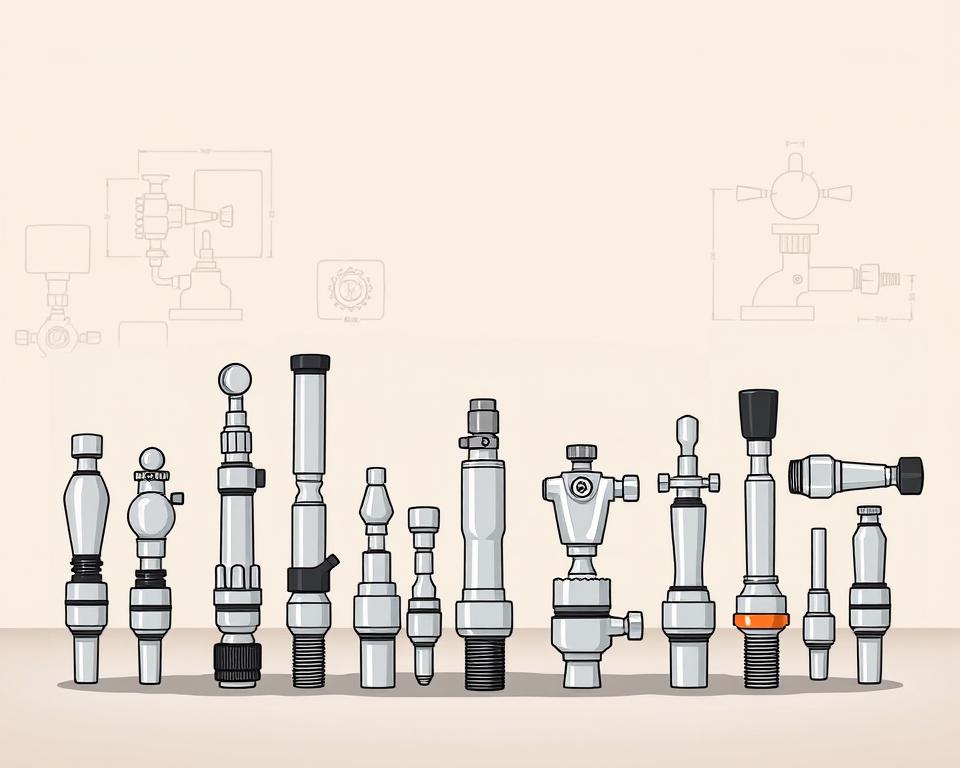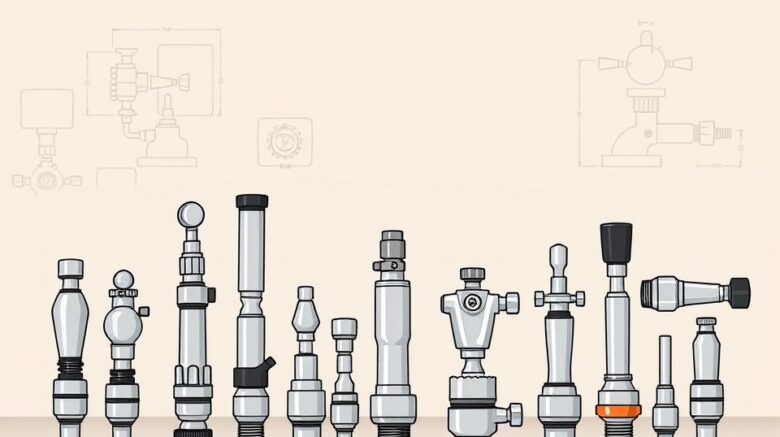Home Keg Coupler Components: Must-Have Kegerator Accessories
Curious why your draft beer ends up too foamy or disappointingly flat? Those issues often trace back to the little parts that bridge your keg and tap. Without the right setup, even the best brew can lose its crisp taste and perfect carbonation.
Installation Parts Supply understands that flawless pours begin with reliable components. No matter if you brew at home or simply enjoy draft beer, knowing these d system keg coupler parts makes all the difference.
Every part—from the washers to the gas lines—matters for keeping the right pressure and taste. More than nine out of ten pour problems stem from mismatched or worn parts. Understanding these parts is the key to a trouble-free draft system.
Main Points
- The correct coupler choice means perfect carbonation and flavor.
- Count on Installation Parts Supply for trusted draft setup parts.
- Regular maintenance prevents common pouring problems.
- Various brews call for particular coupler designs.
- The majority of malfunctions start with coupler problems.

Define the Kegerator Coupler
A flawless draft begins with the proper keg-to-tap link. A keg coupler bridges your CO₂ cylinder or nitrogen tank to the beer line, using compressed gas to push liquid smoothly to your taps. Consider it the powerhouse of your draft beer system—remove it, and the flow stops.
It both pumps gas in to pressurize your keg and regulates how the beer exits. Its interior consists of a probe, a check valve, and distinct ports for beer and gas. These components work together to maintain carbonation and prevent excess foam.
| Component | Function | Common Issues |
|---|---|---|
| Coupler Probe | Punctures the keg seal | Misalignment causes leaks |
| Check Valve | Stops beer from flowing backward | Flat pours from worn seals |
| Gas/Liquid Ports | Links to tubing | Loose fittings create foam |
Misconnecting the coupler is a common error—three out of four novices slip up. The result? Foamy messes, leaks, or worse, spoiled beer. Installation Parts Supply supplies charts and video tutorials to guide you.
Even “universal” styles need to correspond with your keg’s standards. Using the wrong coupler can harm both your pour and your gear.
Types of Keg Couplers and Their Uses
Different beers call for different couplers. The correct coupler preserves carbonation and taste. Follow this guide to choose the right one.
D-Type Coupler (Sankey)
This is the go-to for 85% of North American craft beers. The one-valve mechanism snaps firmly into place. Pro tip: Look for the Sankey name stamped on the side.
Nitro (U) Coupler
Recognizable by its harp logo, this type is a must for nitro beers like Guinness. It uses a unique gas blend (75% nitrogen) to create that creamy head. Don’t jam a U-style onto a regular keg—no proper seal results.
Reverse-Thread S System Coupler
European kegs like Heineken fit this left-twist coupler. Its reverse thread stops you from screwing it onto a D keg. Fun fact: It’s slightly taller than its American cousin.
Specialty European Couplers
German and UK beers demand specialized connectors:
- A-Type Coupler: Fits Paulaner and Warsteiner kegs perfectly. That slider lock never slips.
- G System: Used by UK pubs for Bass and Boddingtons. A pub staple across the UK.
- M System: Locks onto Schneider Weisse kegs. The slide-lock clicks when secure.
Installation Parts Supply color-codes their compatibility guides—green for D, black for U, blue for S. A brewery in the Midwest reclaimed $3,000 a year after matching couplers properly. Never rely on “universal”—real compatibility wins.
Coupler Parts Breakdown
Smooth flows come from well-crafted coupler pieces. Each component helps maintain carbonation and flow. Let’s break down the key hardware that keeps your system running.
Probe + Return Valve
A stainless probe punctures the seal to regulate flow. High-end probes outlast budget ones by threefold. Below it, the check valve blocks backflow—Installation Parts Supply’s most-replaced part.
Nut and Washer Assembly
Everything tightens up around the hex nut. Brass is economical; stainless fights rust. Use nitrile washers in the cold—EPDM fails below 40°F.
| Part | Construction | Key Benefit |
|---|---|---|
| Probe | SS | Long-lasting |
| Check Valve | FDA-approved plastic | Prevents flat beer |
| Hex Nut | Brass or Stainless | Cost-effective & durable |
Gas and Liquid Ports
Your gas port should see 20–30 PSI pressure. Mismatched pressure causes foam. Stick to 3/16″ ID beer lines for smooth pours. Keep a rebuild kit on hand for quick fixes.
Pro Tip: Change seals twice a year or per 50 kegs. A cheap washer swap saves you from a costly rebuild.
Coupler Installation Guide
Getting your draft system right means perfect pours every time. Proper installation prevents foam, leaks, and flat beer. Use this step-by-step for a seamless install.
Mounting the Coupler
Raise the lever, line up the lugs with slots. Twist until firm; don’t over-torque or harm the seal. Choose low-profile to gain 4–5″ clearance.
Use our torque wrench to set nuts at 8-10 ft-lbs. Most leaks—about 80%—come from probe misalignment. New washers keep your system sealed.
Line Connections
Use 5/16″ MFL fittings to attach the gas line. A bit of sealant stops gas leaks. For beer lines, 10–12 feet of 3/16″ tubing balances pressure drop.
| Task | Equipment | Note |
|---|---|---|
| CO₂ Line | Pipe dope | Check with 30 PSI leak test |
| Draft Line | Tubing cutter | Cut straight for proper seals |
| Leak Test | Soapy water | Check for 24 hours |
Modern rigs offer app-based pressure feedback. Our quick-connects helped a Denver bar slash foam by forty percent. Turn off gas immediately if you spot big leaks.
Coupler Troubleshooting
A foam burst spoils your draft faster than anything. Identify these key spots and you’ll solve most pour problems. Let’s tackle the frequent headaches and their solutions.
Foam & Leak Fixes
Sixty-eight percent of draft issues are foam-related. First, confirm the beer is at 38°F, which is optimal for ales. Warm beer releases CO₂ prematurely.
Check each draft line connection next. Soap and water will bubble up where gas is escaping. Tighten any loose fittings with a wrench, but don’t over-tighten.
- Check ball can lead to uneven pours and audible leaks
- Pressure imbalance? Compare your gauge to this chart:
| Beer Type | CO₂ Pressure | N₂ Ratio |
|---|---|---|
| Pilsners | 10–12 | N/A |
| Stouts | 25–30 | 75% nitrogen |
Coupler Fit Problems
Loose couplers almost always trace back to worn seals. Our data shows O-ring swaps resolve 40% of loose fits. If the face is warped, swap the entire coupler.
For uneven surfaces, try keg shims. These inexpensive plastic wedges stabilize wobbling connections. Low-profile models solve clearance problems in compact coolers.
Pro Tip: An emergency kit with five washers fixes most sudden leaks. Staff who learned these tips reduced waste by nearly 20% in Chicago.
If your CO₂ tank frosts up, you’re running too hard. Let it thaw before adjusting pressure relief valves. Annual gauge calibration keeps readings true.
Coupler Cleaning & Care
A clean draft system means crisp, fresh-tasting beer every pour. Over time, residue builds up, affecting flavor and dispensing performance. Regular care preserves performance.
Disassembly and Soaking
Start by taking apart the coupler. Take off the handle, pull out the probe and valve. Soak everything in a PBW bath (1 oz per gallon) for about 15–20 minutes. That will strip away yeast residue and hop buildup.
Our brushes get into the smallest crevices. Don’t forget the ball valve—it accumulates debris. Flush well to prevent soap residue.
Choosing the Right Cleaning Solution
PBW (Powdered Brewery Wash) is a top pick for its pH balance. Acidic solutions are efficient yet rough on rubber. Ultrasonic cleaners remove buildup in pro bars.
- Air Drying: Blow dry or wipe with a microfiber towel.
- Disinfecting: Adhere to CFR 117—30-second dwell time.
- Logs: Track cleanings with a template.
UV light options add extra protection for rubber components. Always neutralize wastewater—PBW is alkaline and harms pipes. A little effort ensures quality pours and extends your system’s life.
Conclusion
Enjoy crisp, fresh beer by mastering your draft beer system. Matching the right hardware, regular cleaning, and proper setup make all the difference. Count on Installation Parts Supply for ongoing support and rebuild-kit deals.
Regular upkeep can stretch your hardware lifespan by seven years. Grab the free compatibility guide or sign up for a pro webinar. A quick annual inspection ensures trouble-free operation—just ask their 5-year satisfied customers.
Upgrade now—stop by Installation Parts Supply and boost your home setup.
